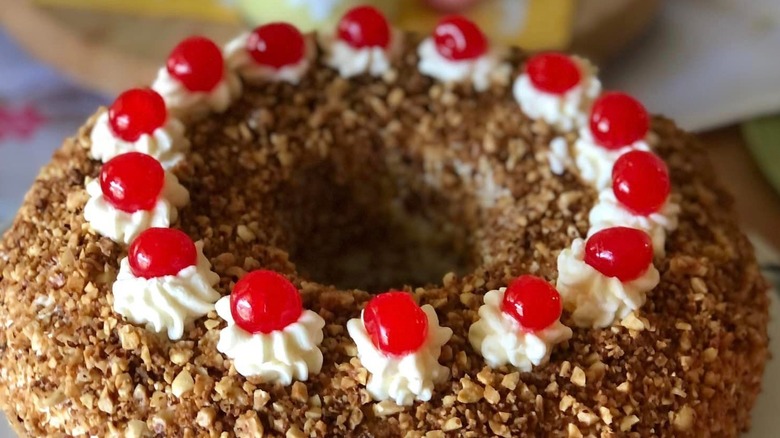The Mysterious Origins Of German Crown Cake
Though France is often seen as the epicenter for top-tier baked goods, plenty of other nations have more than their fair share of beloved baked confections. In particular, maybe no nation takes to cakes quite like Germany. There's the unique black forest cake and streusel coffee cake, and even baumkuchen, the German cake that takes three hours to make.
Then there's German crown cake, a unique entry among baked goods that makes a great starter effort for those looking to get into making German cakes. It's a ring-shaped sponge cake with three layers of buttercream and fruit jam, covered in more buttercream. Its most distinguishing feature might be its brittle-nut topping, known as "krokant" in German, which usually consists of caramelized hazelnuts. Finally, German crown cake is often topped with some sort of red fruit (cherries and raspberries are two favorites) sitting on individual swirls of cream.
Unlike German chocolate cake, which isn't German at all, German crown cake absolutely does come from Germany. We know exactly where it comes from too, as its other name is "Frankfurter crown cake" ("Frankfurter kranz" in German) after the city of Frankfurt. We even have a year for its creation: 1735. But we have absolutely no idea who first baked it (other than that they were likely a master baker), as their name has been lost to time — and one oft-repeated theory about why it was baked has a significant hole in it.
German crown cake wasn't made for an Emperor's coronation
A lot of sources will point to the idea that the German crown cake was created for the coronation of a Holy Roman Emperor. There's just one problem: There was no Holy Roman Emperor crowned in 1735, as Charles VI, the long-serving ruler of the politically complex nation, would still be around for several more years. Indeed, the next coronation occurred in 1742 when Charles VII took the throne.
So if the German crown cake wasn't named after a specific coronation, how did it get its name? The most likely explanation is that Frankfurt was where coronations of Holy Roman Emperors often took place, specifically in the Frankfurt Cathedral. As a result, Frankfurt was also known as the "crown city" of the Holy Roman Empire. So in all likelihood, the cake took its name from the fact it was conceived in Frankfurt.
It could also have something to do with the shape of the cake itself, with a ring shape pretty similar to a crown. The red fruit sitting on top of the cake could also be meant to symbolize the gemstones often found on a crown. But regardless of which of these theories is true, we still have absolutely no idea who baked it in the first place — although we certainly know they knew what they were doing with baked goods.

